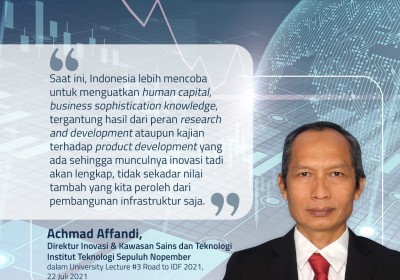Technology Key in Diversifying Economic Growth Across Indonesia
August 04, 2021
JAKARTA – Indonesia currently places 85th out of 131 countries in the World Intellectual Property Organization's 2020 Global Innovation Index, which is the same position it has held since 2018.
There are two global indexes which measure a country's economic competitiveness, which are the Global Innovation Index and the World Economic Forum's Global Competitiveness Index ranking. Indonesia scored high in 4 out of 7 pillars in the Global Innovation Index, which are infrastructure, market sophistication, knowledge and technological output and creative output. However, Indonesia scored low in 3 pillars: institutional strength, human capital and research quality, and business sophistication knowledge.
"Indonesia is currently trying to strengthen its human capital and business sophistication knowledge qualities, both of which depend on the role of research and development and product development efforts in the country. These factors are crucial in ensuring the emergence of innovation from the country would become an added value going forward," explained the director for innovation and scientific sectors at the 10 November Technological Institute Achmad Affandi during the University Lecture #3 Road to Indonesia Development Forum 2021 webinar on Thursday (22/7).
Achmad added that any added value that might arise would not come from the manufacturing process, but from the robustness of the patent & technology and the brand & services processes. Technology, he says, cannot be given without an open network in which it can function effectively. That is why the cooperation between relevant institutions must be forged so that the development and construction of special economic zones (KEK) would run smoothly. Without it, KEKs in Indonesia will struggle to grow.
Indonesia currently has 19 KEKs, more than 120 industrial estates (KI), 37 science & technology parks and 4593 tertiary education institutions across the country.
"However, we must work to improve the diversity of these areas, which are predominantly located in Java. These institutions are proof of our capability to develop. Also, we do not have a lot of institutions that are considered 'leading'. These problems, we must tackle on first," he explained.
The construction of more KEKs, Achmad added, must consider the opportunities for synergy among many relevant stakeholders so that there will be more collaborative clusters within the industrial zones, such as, for example, the steel industry and the agrobusiness industry working together.
"If the progress of our research & technology efforts are based on the specific zone's needs, then all we need to do is just get involved there, for example from developing prototype engineering products, testing and others. By doing so, we would achieve this synergy even if what is being done has not spread comprehensively yet," he said.
The government's role, said Achmad, is crucial in letting this industrial development grow through the utilization of industry internship programs, the upstreaming of innovations and the involvement of educational figures. Collaborations that involve high-end technology and large funding will strengthen resources and narrow their specifications based on certain industrial needs going forward.
Clusters that encourage collaboration will foster a healthy ecosystem which will then help the KEK grow further.
Indonesia’s Research Institutions Supporting the Development of the Electric Vehicle Industry
Indonesian Muslim Fashion and Cosmetics IKMs Shine at Dubai World Expo 2020
Govt Steps Up UMKM Transformation Efforts in the Midst of Pandemic Slowdown
Govt Encourages Promotion of IKM Products in Digital Era
Government Begins Developing Maritime Training Center in Makassar
Tweets by IDDevForum
